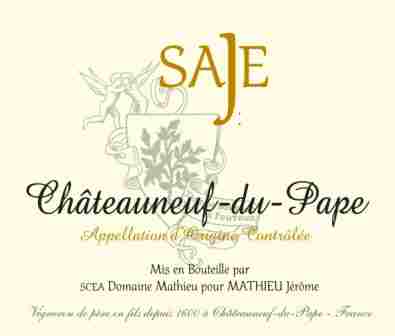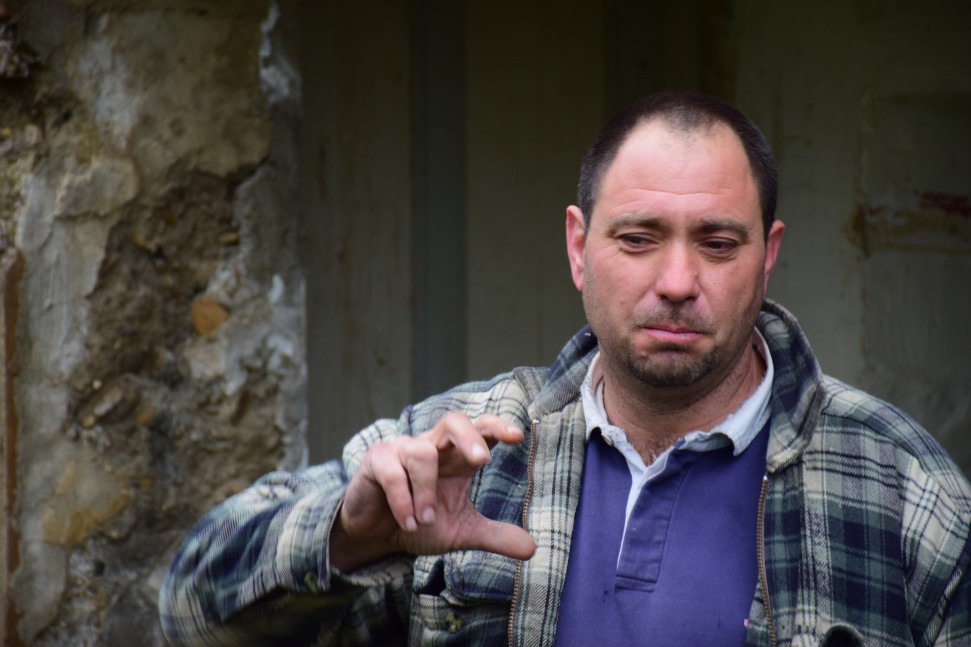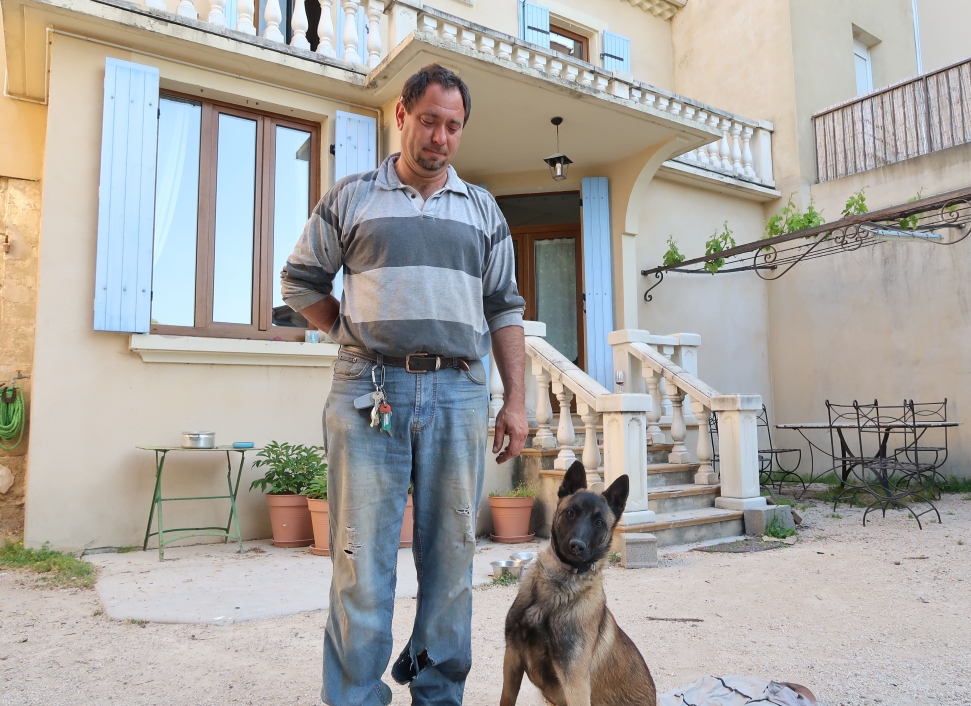Domaine de Saje, Châteauneuf-du-Pape

| Country & Region | France, Rhône Valley |
| Appellation(s) | Châteauneuf-du-Pape, Côtes du Rhône |
| Producer | Jérôme Mathieu |
| Founded | The Mathieu family is one of the oldest in the village, going back to the 16th century. Domaine de Saje was founded in 2015. |
This small estate is run by Jérôme and Sabinne Mathieu, and their first vintage was 2015. The wines are classically made and encompass almost all of the permitted varieties (includes lots of white grapes) which gives the wines a unique personality.
—Jeb Dunnuck, 2017
For many years, Jérôme Mathieu worked alongside his brother André at Domaine Mathieu, managing the estate passed down from their parents. In 2015, André’s eldest son came of age, and the brothers amicably agreed to split the domain to have clear lines of inheritance. Jérôme, who lives in his grandfather’s house in the center of the village, subsequently spent 2015-16 revamping his grandfather’s old cellar to prepare to make wine under his own roof as of 2016. He created Saje and began to use this label with the 2013 vintage – a vintage he made with his brother and, as with the 2014 and 2015 vintages, divided along agreed partitions. Saje is an abbreviation of the names of his wife and son as well as his own; it’s also a play on the French word sage, which means the same in French as it does in English: to be wise. No doubt the name appealed to Jérôme’s lively humor, but it also struck an innate chord within him. The Mathieu family is the oldest wine producing family in Châteauneuf. The wisdom of the ages is something keenly felt, and goes a long way toward explaining his staunch traditionalism. It’s worth noting that this is one of the few growers who never went down the super ripe rabbit hole that so many of the appellation’s producers dove into during the last twenty years (in an unfortunate commonality with Napa Valley).

Jérôme’s inheritance amounted to 9.4 hectares of which 7.4 (just over 23 acres across 26 parcels) is in Châteauneuf-du-Pape, with 2 hectares (five acres divided into two parcels) in appellation Côtes du Rhône. The Châteauneuf holdings are spread all over the appellation in various exposures, elevations, and soils. In the traditional manner, most are based on Grenache but are co-planted with many other varieties, adding up to all 13 permitted varietals. Each parcel is harvested en masse and fermented. As a result, Jérôme enjoys a great deal of diversity with terroir and grape variety, which gives his wines an additional measure of complexity while also mitigating against high levels of alcohol in the wine (field blends need to be harvested at an average level of ripeness, whereas single-varietal parcels can easily be picked at an advanced level of ripeness tailored to a given varietal if so chosen).

As noted, the style here is traditional. The reds ferment spontaneously, age in large concrete vats over the winter, and then are racked into old foudres (Jérôme eschews small barrels). Of Jérôme’s 26 parcels, only one is planted mono-cépage – a parcel of Syrah growing in trellised rows (the others are all head-pruned field blends). This Syrah he normally de-stems except in good, ripe years, while the other varieties he only de-stems if the vintage is difficult and the grapes are not altogether healthy. His classic Châteauneuf is a decidedly old school construct without pumped up fruit, oak, or alcohol. The same is true for his super old-vine cuvée Marquis Anselme and for his Counoise-based Cuvée 1600. These wines all share the common aim of sumptuous ripeness – the basis for Châteauneuf’s fame – without crossing over into surmaturité. Jérôme likes fruit, spice, and elegance.

Pictured above: Jérôme’s ancient crawler with an equally ancient Perkins engine from England. By the way, Jérôme lives and makes wine on the Rue Commandant Lemaitre, the main street running through the village. When asked who Commandant Lemaitre was, he replied with a shrug: “He was the husband of one of the sisters of my great grandfather.”

Thanks to Jeff Bramwell for the shot from Châteauneuf vines looking across the Plain de Dieu to the Dentelles – foreground, left – and to Mt. Ventoux beyond.

The Wines
| Wine | Blend | Description |
|---|---|---|
| Côtes du Rhône Cuvée Château Mar | Based on Grenache with roughly 35% Syrah | From 5 acres that grow across the AOC border of Châteauneuf, just northwest of the Maucoil and Cabrières zones. Raised in concrete vats. The wine is made "on the fruit," Jérôme says, and he’s not kidding. Production averages 700 cases. |
| Châteauneuf-du-Pape Blanc | 100% Clairette | From a half acre parcel of Clairette growing behind Jérôme's house immediately south of the village. Raised on its fine lees in a small enameled steel tank; malo blocked by filtration to retain freshness. Production averages a couple of hundred cases. |
| Châteauneuf-du-Pape | Based on 80-85% Grenache, followed by a field blend of the other 12 permitted varietals. | Raised in foudre for 14 to 16 months, bottled without fining and with only a very light filtration. Production averages 1,300 cases. |
| Châteauneuf-du-Pape Cuvée Marquis Anselme Mathieu | Based on 85% Grenache, followed by a field blend of all the other permitted varieties, even the whites (13 varietals in sum) | This magnificent wine comes from three centenarian parcels: one acre planted in 1890 in La Font du Pape in brown limestone-clay soils; another parcel of two-thirds of an acre planted in 1906 in Tresquous on galets roulés; and a final parcel of just under a half an acre planted, like the above, in 1906 but in the lieu-dit of Cabrières in clay soils. This cuvée is raised in Jérôme's oldest foudre for 14-16 months. Made only in good years; production averages two hundred cases. Anselme Mathieu was a 19th century ancestor renowned for his wine and poetry who helped found Le Félibrige in 1854, a group dedicated to preserving the language and customs of Provence. |
| Châteauneuf-du-Pape Cuvée 1600 | Based on Counoise, followed by field blends led by Grenache. | Jérôme first made Cuvée 1600 in vintage 2015. He made about 100 cases from a blend of 42% Counoise, 20% Grenache, 20% Mourvèdre, with the ten other varieties making up the difference. Subsequently, the percentage of Counoise grew to well over 50% and production increased to around 200 cases. The wine is raised both in tank and in an old foudre. The name comes from the written record. The year 1600 saw the first mention of a Mathieu in Châteauneuf-du-Pape: a record of a marriage in the village church. That ancestor's occupation was noted as Cultivateur de vigne. |